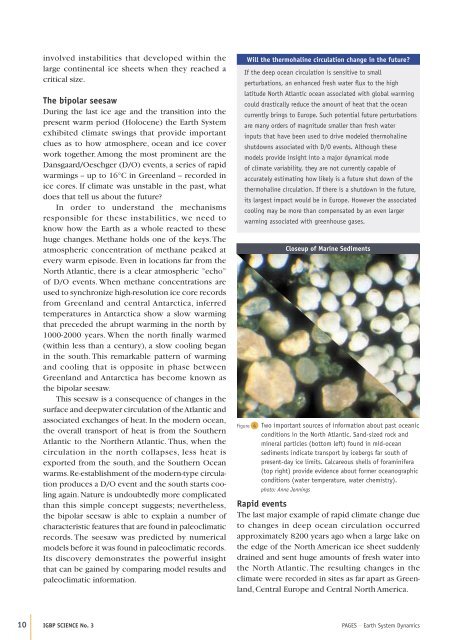Environmental Variability and Climate Change
Environmental Variability and Climate Change
Environmental Variability and Climate Change
Create successful ePaper yourself
Turn your PDF publications into a flip-book with our unique Google optimized e-Paper software.
involved instabilities that developed within the<br />
large continental ice sheets when they reached a<br />
critical size.<br />
The bipolar seesaw<br />
During the last ice age <strong>and</strong> the transition into the<br />
present warm period (Holocene) the Earth System<br />
exhibited climate swings that provide important<br />
clues as to how atmosphere, ocean <strong>and</strong> ice cover<br />
work together. Among the most prominent are the<br />
Dansgaard/Oeschger (D/O) events, a series of rapid<br />
warmings -- up to 16°C in Greenl<strong>and</strong> -- recorded in<br />
ice cores. If climate was unstable in the past, what<br />
does that tell us about the future?<br />
In order to underst<strong>and</strong> the mechanisms<br />
responsible for these instabilities, we need to<br />
know how the Earth as a whole reacted to these<br />
huge changes. Methane holds one of the keys. The<br />
atmospheric concentration of methane peaked at<br />
every warm episode. Even in locations far from the<br />
North Atlantic, there is a clear atmospheric ”echo”<br />
of D/O events. When methane concentrations are<br />
used to synchronize high-resolution ice core records<br />
from Greenl<strong>and</strong> <strong>and</strong> central Antarctica, inferred<br />
temperatures in Antarctica show a slow warming<br />
that preceded the abrupt warming in the north by<br />
1000-2000 years. When the north fi nally warmed<br />
(within less than a century), a slow cooling began<br />
in the south. This remarkable pattern of warming<br />
<strong>and</strong> cooling that is opposite in phase between<br />
Greenl<strong>and</strong> <strong>and</strong> Antarctica has become known as<br />
the bipolar seesaw.<br />
This seesaw is a consequence of changes in the<br />
surface <strong>and</strong> deepwater circulation of the Atlantic <strong>and</strong><br />
associated exchanges of heat. In the modern ocean,<br />
the overall transport of heat is from the Southern<br />
Atlantic to the Northern Atlantic. Thus, when the<br />
circulation in the north collapses, less heat is<br />
exported from the south, <strong>and</strong> the Southern Ocean<br />
warms. Re-establishment of the modern-type circulation<br />
produces a D/O event <strong>and</strong> the south starts cooling<br />
again. Nature is undoubtedly more complicated<br />
than this simple concept suggests; nevertheless,<br />
the bipolar seesaw is able to explain a number of<br />
characteristic features that are found in paleoclimatic<br />
records. The seesaw was predicted by numerical<br />
models before it was found in paleoclimatic records.<br />
Its discovery demonstrates the powerful insight<br />
that can be gained by comparing model results <strong>and</strong><br />
paleoclimatic information.<br />
Will the thermohaline circulation change in the future?<br />
If the deep ocean circulation is sensitive to small<br />
perturbations, an enhanced fresh water fl ux to the high<br />
latitude North Atlantic ocean associated with global warming<br />
could drastically reduce the amount of heat that the ocean<br />
currently brings to Europe. Such potential future perturbations<br />
are many orders of magnitude smaller than fresh water<br />
inputs that have been used to drive modeled thermohaline<br />
shutdowns associated with D/O events. Although these<br />
models provide insight into a major dynamical mode<br />
of climate variability, they are not currently capable of<br />
accurately estimating how likely is a future shut down of the<br />
thermohaline circulation. If there is a shutdown in the future,<br />
its largest impact would be in Europe. However the associated<br />
cooling may be more than compensated by an even larger<br />
warming associated with greenhouse gases.<br />
Closeup of Marine Sediments<br />
Two important sources of information about past oceanic<br />
conditions in the North Atlantic. S<strong>and</strong>-sized rock <strong>and</strong><br />
mineral particles (bottom left) found in mid-ocean<br />
sediments indicate transport by icebergs far south of<br />
present-day ice limits. Calcareous shells of foraminifera<br />
(top right) provide evidence about former oceanographic<br />
conditions (water temperature, water chemistry).<br />
photo: Anne Jennings<br />
10 IGBP SCIENCE No. 3 PAGES – Earth System Dynamics<br />
Figure 4<br />
Rapid events<br />
The last major example of rapid climate change due<br />
to changes in deep ocean circulation occurred<br />
approximately 8200 years ago when a large lake on<br />
the edge of the North American ice sheet suddenly<br />
drained <strong>and</strong> sent huge amounts of fresh water into<br />
the North Atlantic. The resulting changes in the<br />
climate were recorded in sites as far apart as Greenl<strong>and</strong>,<br />
Central Europe <strong>and</strong> Central North America.

















